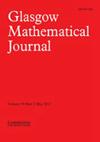图的有限覆盖同调中的子表示
IF 0.4
4区 数学
Q3 MATHEMATICS
引用次数: 1
摘要
抽象Let$p\;:\;Y\toX$是具有相关甲板群$G$的有限图的有限正则覆盖,并且考虑覆盖的第一同调$H_1(Y;\;{\mathbb{C}})$作为$G$表示。本文的主要贡献是拓宽了甲板群$G$的表示理论与$H_1(Y;\;{\mathbb{C}})$中同调类的拓扑性质之间的对应关系和字典。我们通过研究$G$-表示$H_1(Y;\;{\mathbb{C}})$中的某些子表示来做到这一点。$\pi_1(X)$中基元的提升的同调类跨越$H_1(Y;\;{\mathbb{C}})$中的诱导子表示,并且我们证明了如果$G$是阿贝尔的,则该性质永远不足以刻画这种同调类。我们研究了$H_1^{\textrm{comm}}(Y;\;{\mathbb{C})\leq H_1(Y;&;{\ mathbb{C{})$——$\pi_1(X)$中基元交换子的提升的同调类所跨越的子表示。具体地,我们证明了这样一个同调类的跨度同构于两个诱导表示的商。此外,我们构造了具有$H_1^{\textrm{comm}}(Y;\;{\mathbb{C}})\neq\ker\!(p_*)$。本文章由计算机程序翻译,如有差异,请以英文原文为准。
Subrepresentations in the homology of finite covers of graphs
Abstract Let
$p \;:\; Y \to X$
be a finite, regular cover of finite graphs with associated deck group
$G$
, and consider the first homology
$H_1(Y;\;{\mathbb{C}})$
of the cover as a
$G$
-representation. The main contribution of this article is to broaden the correspondence and dictionary between the representation theory of the deck group
$G$
on the one hand and topological properties of homology classes in
$H_1(Y;\;{\mathbb{C}})$
on the other hand. We do so by studying certain subrepresentations in the
$G$
-representation
$H_1(Y;\;{\mathbb{C}})$
. The homology class of a lift of a primitive element in
$\pi _1(X)$
spans an induced subrepresentation in
$H_1(Y;\;{\mathbb{C}})$
, and we show that this property is never sufficient to characterize such homology classes if
$G$
is Abelian. We study
$H_1^{\textrm{comm}}(Y;\;{\mathbb{C}}) \leq H_1(Y;\;{\mathbb{C}})$
—the subrepresentation spanned by homology classes of lifts of commutators of primitive elements in
$\pi _1(X)$
. Concretely, we prove that the span of such a homology class is isomorphic to the quotient of two induced representations. Furthermore, we construct examples of finite covers with
$H_1^{\textrm{comm}}(Y;\;{\mathbb{C}}) \neq \ker\!(p_*)$
.
求助全文
通过发布文献求助,成功后即可免费获取论文全文。
去求助
来源期刊
CiteScore
1.10
自引率
0.00%
发文量
36
审稿时长
6-12 weeks
期刊介绍:
Glasgow Mathematical Journal publishes original research papers in any branch of pure and applied mathematics. An international journal, its policy is to feature a wide variety of research areas, which in recent issues have included ring theory, group theory, functional analysis, combinatorics, differential equations, differential geometry, number theory, algebraic topology, and the application of such methods in applied mathematics.
The journal has a web-based submission system for articles. For details of how to to upload your paper see GMJ - Online Submission Guidelines or go directly to the submission site.

 求助内容:
求助内容: 应助结果提醒方式:
应助结果提醒方式:


